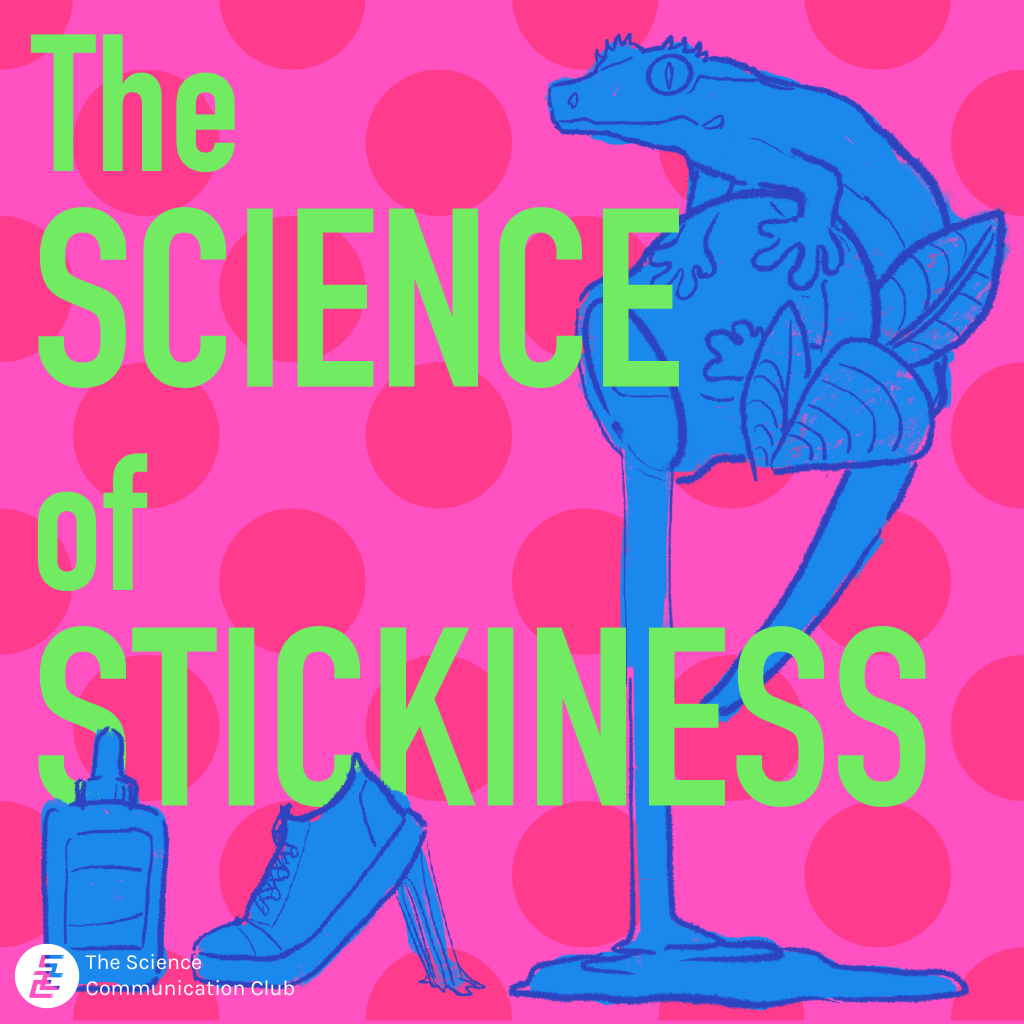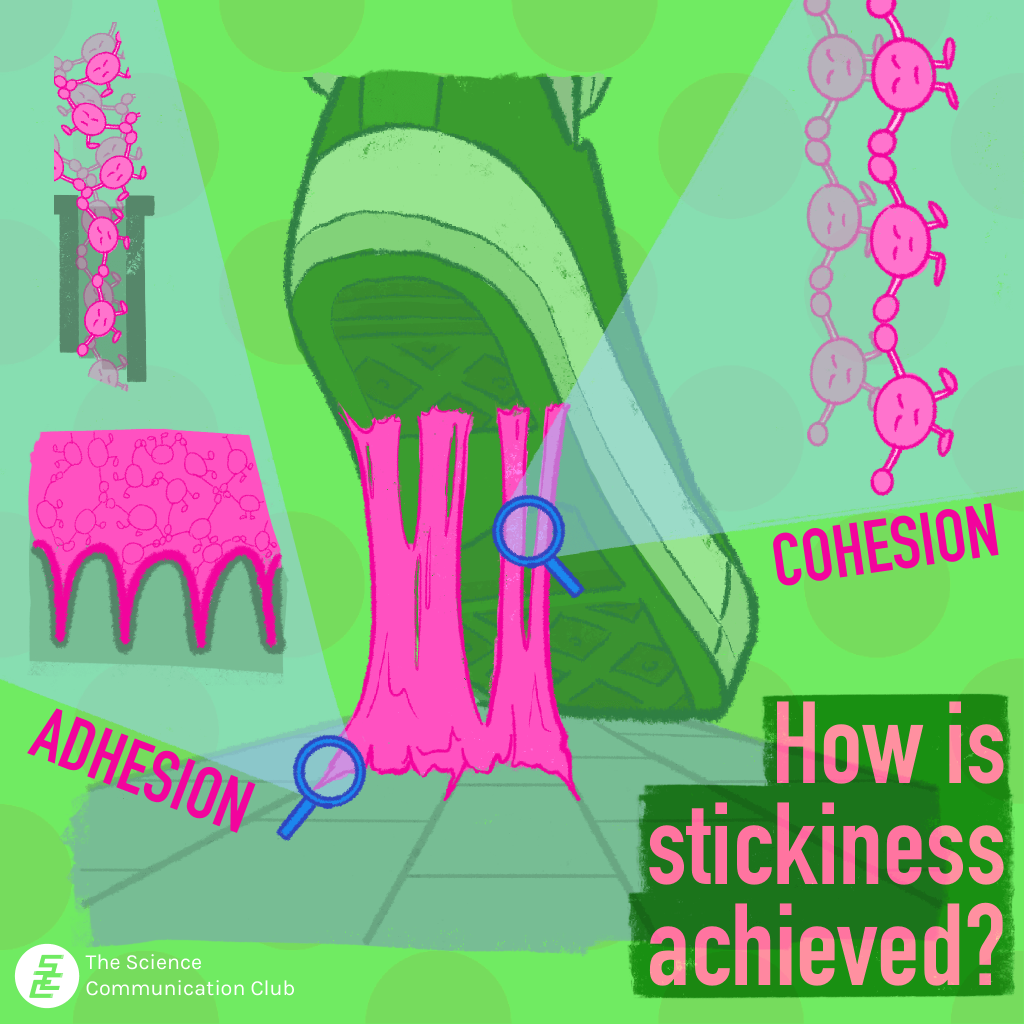
Written by Quinn Lui
Illustrated by Yik Lok Wong
One of the greatest joys of elementary school art classes was white glue: specifically, letting it dry on your hands and then peeling it off. But if you were too impatient and touched something while the glue was still drying, you’d be left with sticky belongings that soon collected grime. The same problem came about when we got to build towers with toothpicks and marshmallows: squish them too much, and they’d turn into a gooey mess in your hands.
No matter what type of student you were, stickiness is present in so many of our school-related memories. We bookmarked textbooks with post-it notes, put up posters with blue sticky tack, and taped photos of our friends inside our locker doors. But though we were learning how it felt, how to clean it up, and how to get away with leaving chewed gum underneath our desks, few of us were taught how stickiness actually works.
The basics of stickiness
Sticky substances are high in viscoelasticity. This means that depending on the situations they’re placed in, they may flow like liquids, or they may stretch out and then return to their original form. When two materials come into contact, molecules on the touching surfaces interact, producing attractive forces that bind them together. The more points of contact exist between the two materials, the more opportunities exist for these molecular interactions to occur, and the stronger their bond becomes. Notably, materials that stick to each other aren’t necessarily altered by the interactions between their molecules. That’s what allows you to peel glue off your skin after it dries: there’s no new substance being created where the glue meets flesh, so it can come apart.
This ability to stick to other, dissimilar materials is called adhesion. Being able to flow is important to adhesion because it increases the points of contact between two materials. Think about what happens when you spill milk on a tile floor, versus dropping a piece of paper: the milk runs into the gaps between the tiles, entering deep into any cracks or inconsistencies. Meanwhile, the paper will just slide smoothly across the floor.
However, adhesion isn’t the whole story. If a substance can be easily pulled apart, it won’t be much use in sticking objects together. That’s where cohesion—a material’s ability to stick to similar materials, including itself—comes in. Solids are usually high in cohesion. Their molecules tend to be strongly bound to each other, allowing solids to keep their shape.
A material that’s both adhesive and cohesive, like honey, can be successfully sticky! It’ll flow easily when drizzled across a waffle, settling into all the holes on the surface. But because it also holds itself together, it won’t soak right through. It’ll also help keep any other toppings in place.

Why study stickiness?
Stickiness can produce a lot of fun projects for school-aged kids, as well as delicious treats, but that doesn’t mean that scientists don’t take stickiness seriously. Besides the day-to-day convenience offered by masking tape or sticky notes, various industries rely heavily on stickiness. For instance, construction projects are often assembled using particularly heavy-duty glues. Caulk, the white substance that usually surrounds sinks or bathtubs or toilets, is a construction adhesive that appears in many kitchens and bathrooms.
By studying natural adhesives, from tree sap to gecko skin, scientists can come up with ways to reproduce these properties in man-made ones. But stickiness researchers don’t just learn from nature—their work gives back to it, too. Most wood products were once made with a type of glue which released cancer-causing chemicals into the environment where it was created. Around fifteen years ago, though, a group of scientists at Oregon State University created a soy-based, non-damaging alternative glue. They were inspired by ocean mussels, which are sticky enough to cling to underwater rocks even when the force of the tides washes over them.
Unlike some other natural adhesives, the bonds created by marine invertebrates stay strong even when you add water. This particular phenomenon has led scientists to develop a longer-lasting dental adhesive for attaching dentures to teeth. Typical dental glue can easily break down due to constant contact with saliva, but this one actually responds to wet conditions by actively strengthening itself.
Mussel research takes place at UofT, too. Zebra and quagga mussels are two invasive species in North American water bodies, and according to investigations done by the Department of Material Sciences and Engineering, their ability to adhere to various surfaces may outstrip previously studied species of mussels. Learning what makes these mussels so sticky will improve industrial and medical adhesives, as well as help scientists make headway in creating surfaces that they can’t bond to. One day, these invasive species might no longer be able to stick around in our lakes, either literally or figuratively!
Sources:
- Chang, K. (2007, July 27). The Science of Sticky. The New York Times. https://tierneylab.blogs.nytimes.com/2007/07/27/the-science-of-sticky/
- Irving, T. (2022, January 17). Why are zebra mussels so sticky? Study could lead to new industrial coatings, medical adhesives. UofT News. https://www.utoronto.ca/news/why-are-zebra-mussels-so-sticky-study-could-lead-new-industrial-coatings-medical-adhesives
- James, B. D., Kimmins, K. M., Nguyen, M.T., Lausch, A. J., & Sone, E. D. (2021). Attachment of zebra and quagga mussel adhesive plaques to diverse substrates. Scientific Reports 11. https://doi.org/10.1038/s41598-021-03227-6
- Moskowitz, C. (2008, September 2). The science of stickiness revealed. Live Science. https://www.livescience.com/2818-science-stickiness-revealed.html
- Science Daily. (October 16, 2007). Glue goes green. https://www.sciencedaily.com/releases/2007/10/071014193722.htm
- Song, L., Ye, Q., Ge, X., Misra, A., & Spencer, P. (2016). Mimicking nature: Self-strengthening properties in a dental adhesive. Acta Biomaterialia, 35, 138–152. https://doi.org/10.1016/j.actbio.2016.02.019